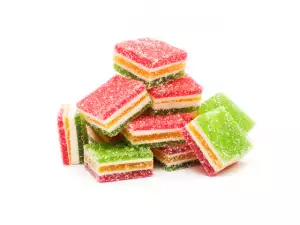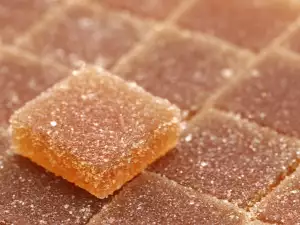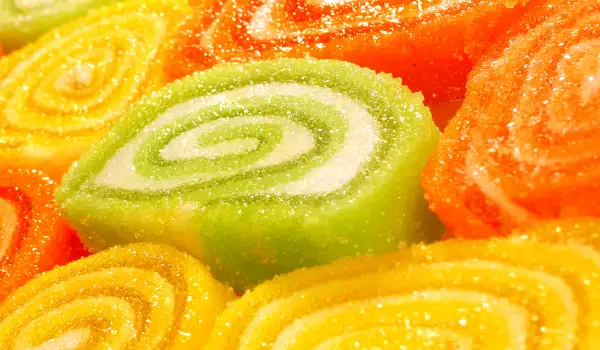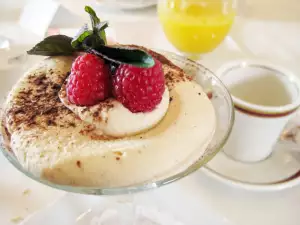Turkish Delight is a pastry made from starch and sweetened with sugar water. In the majority of cases, it may be flavored with lemon or rose water. Usually not to stick after being diced, they are dusted with powdered sugar or coconut chips. Turkish Delight is known worldwide, but is widely enshrined in the Bulgarian, Albanian, Turkish, Greek, Cypriot and Romanian cuisine.
History of Turkish delight
Turkish Delight is one of the oldest sweets in the world. For it, we must be grateful to the culinary masters of the Ottoman Empire. Somewhere in the 15th century, the Sultan of the court ordered a pastry chef, to stir up an unheard of sweet temptation to please his harem of women. After many attempts, the cook made Turkish delight by mixing sugar, with various spices and nuts. Legends are full of much delight and its existence is mentioned in the 12th century, when Richard the Lionheart ordered a large meal for his wedding. Among the meats, fruits and delicacies on the table, there was also Turkish delight.

Another Slavic legend even tells of a brave man who managed to redeem his beloved in the 14th century, which was intended for the Sultan's harem. The hero served the sultan Turkish delight and his wife returned. Another history of the 17th century did bind Turkish delight to the young confectioner Bekir Effendi, who was able to use ingenuity to appease the Sultan’s bad temper, and then prepared the unconventional treat.
In the 18th century, Turkish delight managed to conquer the hearts of British aristocrats and fit their eternal tea ceremony. During normal drinking of afternoon tea, the nobility in England love to eat Turkish delight.
Turkish Delight is made from starch and sugar-sweetened water. It is often flavored with rose water, vanilla or lemon. Different types of delight can be with nuts, peanuts, pistachios, hazelnuts, coconut and others. Unparalleled by any other sweet temptation, Turkish delight usually comes sliced into small pieces, covered with powdered sugar or coconut.
The land of Turkish delight can be considered to be the Balkans and that’s why it is most popular in the local cuisine there. There are plenty of Turkish delights - Classic Turkish delight, Colored Turkish delight (bergamot), Turkish delight Cream, Mint Turkish delight, Turkish delight Mead, Turkish delight with nuts and all kinds of fruit flavors.
Turks have an old saying: "Eat sweet and speak sweet". From Turkey, the conceptual combination of Turkish delight is a symbol of relaxed contentment and immense pleasure, as indeed might be indicated by the word rahat. By the late 18th century, when it began mass production, Turkish delight is sweetened with honey and grape molasses. After the 18th century and a powerful surge of sugar, Turkish delight was revived in a new era, in the production of traditional cake.
It is said that the great Picasso had eaten Turkish delight daily, to improve his concentration and run easily with a properly talented hand. Napoleon and Winston Churchill were passionate lovers of Turkish delight with pistachios.

Selection and storage of Turkish Delight
Turkish delight can be found in any store. This product is widely enshrined in our cooking, making it easy to find. Buy Turkish delight, located in tightly closed containers. Store in dry, clean rooms, best confined to a suitable box, to avoid drying.
Recipes for Turkish Delight
By itself, Turkish delight is complete confectionery masterpiece, but it also is an excellent supplement to various other pastries. It is delicious to eat pies with delight, other sweets and scones, tarts and cakes, Baked Pasta or muffins, baklava and strudel with delight and others. A traditional recipe for delight is:
flour - 5 tbsp corn
water - 1/2 cup + cold 1/2 cup hot
Sugar - 2 cups
juice - 1/2 cup orange
rose water - 1 tsp, maybe lemon juice
nuts - 2 cups optional
sugar - icing
Preparation of Turkish Delight: Dissolve corn flour in cold water. Put the water to boil, adding sugar and orange juice. Add the flour to these and simmer 15 minutes. During this time, stir often. When you remove the mixture from the heat, add rose water and lemon juice. Pour on nuts, stir the mixture and pour into a buttered form. Allow to cool completely and cut into bite sized bits with a knife dipped in hot water. Roll each piece pf delight in powdered sugar.
The most common recipe for Turkish Delight can be prepared by mixing and stirring 750 g sugar, 1 and 1/2 liters of water, 150 g starch and the juice of 1/2 lemon. The cool delight is cut into pieces and added to powdered sugar or crushed nuts if desired.
Benefits of Turkish delight
It is said that Turkish delight has a therapeutic and healing effect. It’s believed to help with hypertension and an increased content of cholesterol in the body. Turkish Delight is a food high in glucose, hence its positive impact. Glucose supports the functions of the heart and improves the functioning of the brain, but also helps in quick recovery of energy and the body's resistance. Turkish Delight has a long reputation of being a powerful aphrodisiac.
Dangers of Turkish delight
Despite its long history, Turkish delight is at the forefront of junk food, along with chips and sodas. Very often the taste and smell are obtained by using the much maligned E's in it.






















